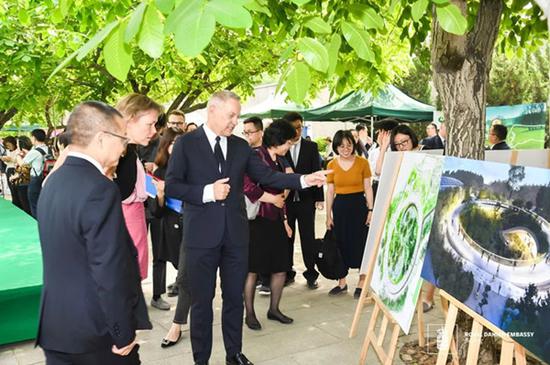Danish Embassy in Beijing celebrates Panda Day

ndres Carsten Damsgaard, Ambassador of Denmark to China, introduces the architecture of the panda enclosure to Zhang Zhihe at the Royal Danish Embassy in Beijing on May 10, 2019. (Photo Courtesy of Royal Danish Embassy)
Still remember the protagonist, Po, from the "Kung Fu Panda" franchise? This character stole many young hearts with his inspiring journey. Po started off as an apprentice noodle maker at his dad's shop and later became the legendary "Dragon Warrior."
However, the DreamWorks animation series alone cannot fully substantiate the popularity of pandas in real life, at least no more than overseas zoos can.
More than a month ago, the Copenhagen Zoo in the capital of Denmark welcomed the arrival of two pandas — six-year-old Xing'er (male) and five-year-old Mao Sun (female)—from the Chengdu Research Base of Giant Panda Breeding in the capital of China's Sichuan province.
Since the arrival of the two pandas, there has been a surge in the number of zoo visitors. According to Bengt Holst, scientific director of the Copenhagen Zoo, the number of visitors has risen from 120,000 in April last year to over 200,000 during the same period this year.
"The pandas are well-received, and the Danish people will be excited for many years from now," said Holst on "Panda Day." The Royal Danish Embassy in Beijing hosted this half-day event on May 10, 2019, to celebrate the safe arrival of the two giant pandas in Copenhagen, Denmark.
"The pandas are doing pretty well. It's as if they have been there for serval years already," said Holst.
According to him, they were expecting the pandas to sit in their cribs after their long journey. However, as soon as they opened the slides, Xing'er, the male panda, walked out immediately and started eating the bamboo.
The two pandas reside in an exquisitely designed enclosure shaped like a Chinese Taichi symbol, representing the male and female principles. In addition to the two separate rooms for Xing'er and Mao Sun, a neutral room has also been built for procreation when they reach maturity in a couple of years.
Inside the enclosure, there is a glass wall dividing the catering room from the pandas' abode.
"The good thing is that they don't look as if they notice the visitors. Actually, they don't care about the number of visitors whether there are only five or 50. It doesn't bother them, which is really good," Holst said.
The pandas' seemingly smooth transition to a new environment is the result of a 10-year partnership between Chengdu and Copenhagen.
"Our cooperation on the research and protection of giant pandas started 10 years ago," said Zhang Zhihe, director of the Chengdu Research Base of Giant Panda Breeding. "One of the examples at the time was the Copenhagen Zoo's donation to the Chengdu Field Research Center for Giant Pandas."
However, according to Zhang, the cooperation between the two organizations goes far beyond financial support. Over the past 10 years, they have been searching for solutions to release giant pandas into the wild gradually. The remarkable achievements will be announced later this year or next year, Zhang disclosed.
From the 1930s to the 1980s, pandas were on the brink of extinction. Some starved as there was a lack of edible bamboo, while others were slaughtered by hunters in their most populated habitat in Sichuan province. As a result, no more than 100 pandas had survived until the establishment of the Chengdu Research Base of Giant Panda Breeding in 1987.
In a bid to establish a self-sustaining captive population and develop reproduction activities to rebuild or reinforce the wild panda population, the base has surmounted the challenges of pandas' low fertilities, malnutrition syndromes, and viral infections to ensure the population of the cubs rise to 195 in 2018.
Moreover, these furry animals are now becoming friendship ambassadors. During their stay in their overseas homes, including Japan, the United States and Spain, these pandas have given birth to 30 cubs.
"Pandas are cute, but they are not only there to entertain us. They are a prominent symbol and example of the work of safeguarding wild animals from the brink of extinction," said Andres Carsten Damsgaard, Ambassador of Denmark to China.
"So giant pandas are also important in raising the awareness of wildlife conservation. This is why the arrival of the pandas in Denmark also marks the beginning of the Sino-Danish giant pandas' joint research operation program," he said while praising Holst and Zhang's decade-long cooperation.

